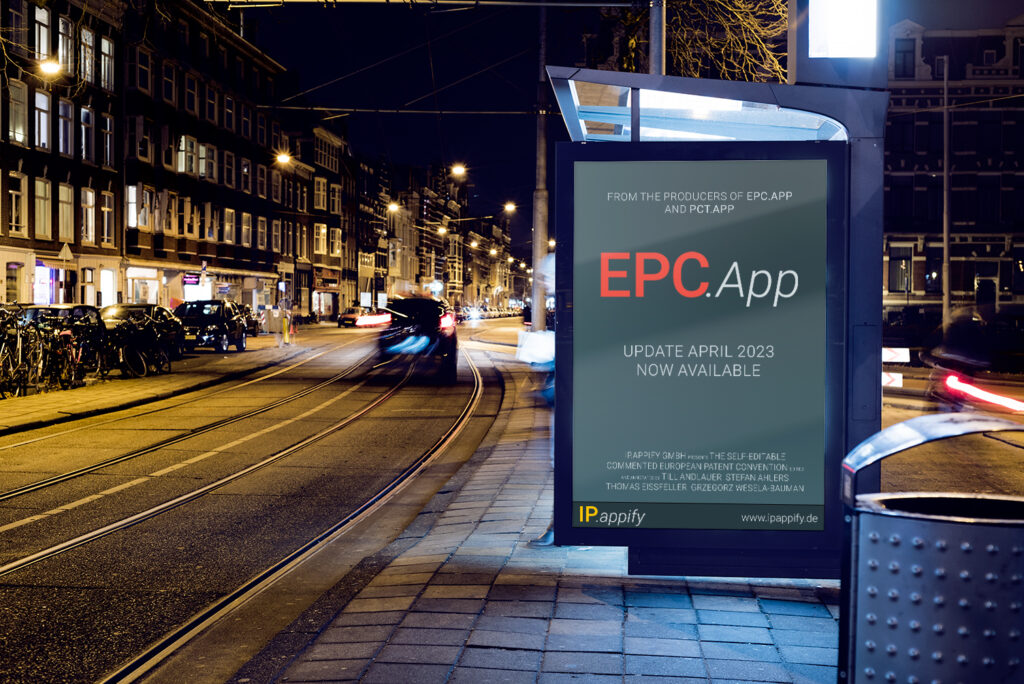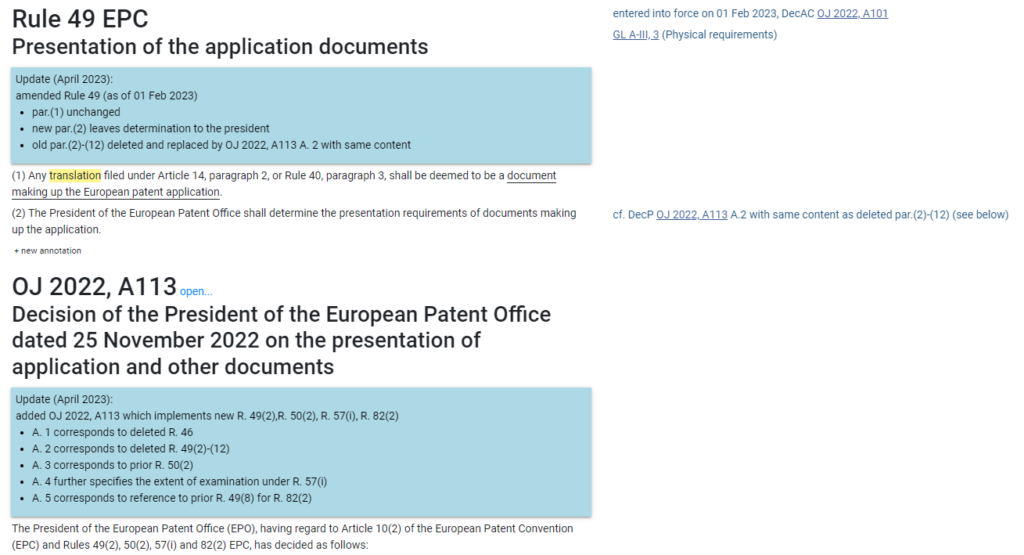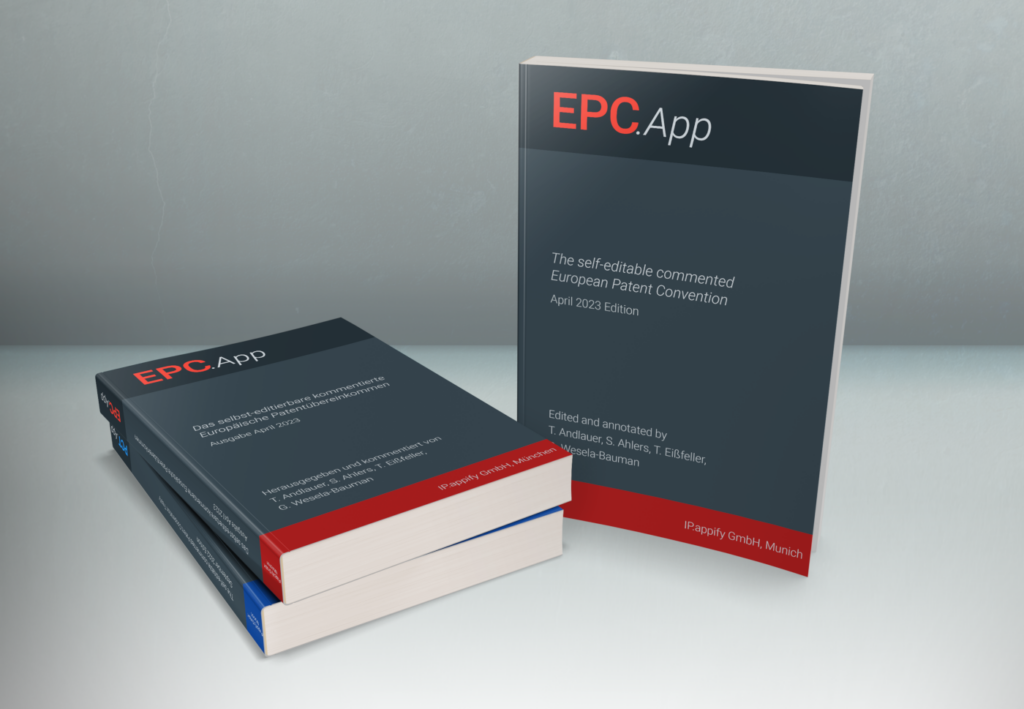The first update this year of our EPC.App reference book to legal status of 1st April 2023 is completed. As usual, the English and German versions are synchronized in content. This meanwhile 10th edition of our EPC commentary includes all Official Journal articles until March 2023 with thereby implied changes of EPC provisions and is intended to be used when starting preparations for EQE 2024.

Key changes since the last update in November 2022 were:
- The new EPO Guidelines valid as of 1 March 2023.
Interesting amendments therein provide more clarity to- consequences of Rule 56a (in force since last November), for example its impact on page fees (GL A-III, 13.2 – open in EPC.App at A. 78), claims fees (GL A-III, 9 – at R. 45), sufficiency of disclosure (GL F-III, 10 – at A. 83), prior art under Art. 54(3) (GL G-IV, 5.1.2 – at A. 54), and more procedural details (at R. 56a)
- appliance of WIPO standard ST.26 (GL F-II, 6.2 – at R. 30)
- conduct of oral proceedings by ViCo after removing temporal limits as decided by the President in OJ 2022, A103 (GL E-III, 8 – at A. 116)
- practice on decisions according to the state of the file (GL C-V, 15 – at A. 97)
- text matter in flow sheets (GL A-IX, 8 – at A. 78)
- storage of multimedia disclosures (GL G-IV, 7.5.6 – at R. 123)
- disregarding accidental anticipations in the evaluation of unity (GL F-V, 3.1 – at A. 82)
- the upcoming abandonment of the 10-day rule as of November 2023, which will be reflected in the next update of EPC.App.
- The EBoA decision G 2/21 has been issued (open in EPC.App at A. 56). The questions of the referral may have created too much hope to receive clarity among different concepts of “plausibility”. Rather, plausibility was dismissed as generic catchword and declared not to be a distinct condition of patentability. It was replaced by the condition that for relying on a technical effect for inventive step, the skilled person needs to derive said effect as being “encompassed by the technical teaching” and “embodied by the same originally disclosed invention”. Some practitioners may have more questions than before on how to apply this. Reviews of this particular and other BoA decisions by Daniel X. Thomas can be found in the CASELAW category of this blog.
- The integrated case law database of the online EPC.App has been complemented by all BoA decisions published until end of March 2023. Decisions thereof can be added or cited in personal annotations as needed using the self-editing functions (illustrated in this video).
- Rules 46, 49, 50, 57, and 82 on format requirements of application documents have been amended as of 1 February 2023. This may be understood as preparation of future changes without effect on current EPO practice. The President has been authorized to determine document format requirements and has decided, for the time being, to leave them unchanged as in the previous rules (OJ 2022, A113 – open in EPC.App at A. 78).
- As a similar preparatory measure, Rule 65 on the transmittal of the European search report has been amended as of 1 February 2023 (open in EPC.App at A. 92). According thereto, cited prior art documents may be made available online by future new digital services and no longer be transmitted together with the European search report. As long as the implementation of such new services is missing, the transmission of cited documents together with the search report remains in place.
- The EPO’s long-lived practice to increase fees only every second year (2020, 2022, …) has been interrupted by an additional increase of EPO fees as of 01 April 2023 (at A. 2 Rfees). The increase of most amounts in the order of 5% may be understood as short term response to recent price increases across Europe. It was more difficult to understand why the announcement came only with publication of the Official Journal on 31 January 2023 after having being decided on 14 December 2022 (OJ 2023, A2). Some users of the system may have made budget plans in-between.
- The upcoming UPCA entry into force on 1 June 2023 has been triggered by Germany’s deposit of the ratification document on 17 February 2023. The UPCA itself as well as the EU regulations on unitary patent protection are not fully reproduced in the author scope of EPC.App. However, the brief summaries at A. 142 and A. 149a have been updated and additional references at related EPC provisions have been added. More specifically, this lead to further comments at A. 64 (infringement of EP patents), A. 65 (alternative to national validation), A. 79 (designation requirements), R.71 (request for delay), A. 138 (revocation option), A. 139 (issues of prior art and parallel protection),and A. 142 (list of states, request for delay, transitory provision, national safety nets).
The above links to the online versions of the book can be followed when being logged-in. A free one month test account is available, which does not extend automatically after expiry.
Feedback from EQE users and tutors has been reviewed and further included in the current update. Like in earlier years, we also tested ourselves the current EQE 2023 with the respectively available November 2022 edition of EPC.App. We believe it was possible to find useful guidance to all EPC questions of pre-exam and paper D. Of course, it is always recommended to further enhance the author comments by own annotations for best results.

As usual, all changes of the update are automatically included in the online version on the next login. And as part of our update service, changes are additionally indicated by more than 70 brief blue update notes in the App as shown in the screenshot above and further explained in the FAQs. Of course, self-edited user content from before the update is retained in the respective personal storage on the webserver, and can be exported into the printable PDF offline version so as to avoid time-consuming transfer of handwritten annotations to the new edition. A 2-minute video illustrating the update process and related functions can also be found in our youtube channel.
To further avoid the need of replacing pages in a folder, a customized color paperback with up-to-date content and typed user comments can be ordered via our integrated print-on-demand service. This is currently offered using a world-wide operating print provider. A further improvement of paper and binding quality is in preparation and will be announced soon.
For those who still prefer to start with a classical printed book, we published also the EPC.App April 2023 Edition as stand-alone black-and-white paperback (see image below). The book is available in English and German via Amazon.

Comments
Leave a comment